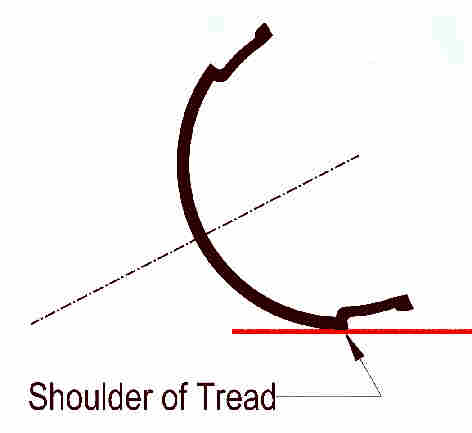"The True Facts of the "Chicken Strip"

"The True Facts of the "Chicken Strip"
Chicken Strips (CSs) are just one of the latest contested subjects about high performance sport bike riding. As with all other subjects there are a myriad of misconceptions and inaccurate theories.
Many riders relate the existence of the CSs to riders' performance or as a telltale sign the bike can go faster or lean over more in a corner. I've even heard some "advice givers" say it's from not hanging off enough, so the rider needs to hang off more.
In actual fact the presents of the CSs only indicates that the edge of the tire has not contacted the pavement while cornering. It is not any form of indicator to the riders' skill or physical limits to the cornering potential of the bike. In the real world of motorcycle dynamics there are several reasons why a tire will have a CS. It is true that one of the reasons is that the rider is riding slowly and not cornering fast but, it's not the only reason or even the main reason.
The main factors that determine the existence and size of the CS are ground clearance, overall traction of the tire, tire size vs. rim size and last but not least, body position.
Traction
Traction available can have a big effect the CS. A tire with a high coefficient of friction can corner faster and lean over further that a harder compound tire. If the tire has enough traction, the bike can lean over far enough to use us the whole tire or to run out of ground clearance, whichever comes first. A tire with lower traction, on the other hand, may run out of grip before all of the tread is used up and leave a CS. Once the tire starts to slide there is no magic way to get more traction to allow the bike to lean over further and use up the CS.
Ground Clearance
Probably the number 1 common cause of the presence of the CS is ground clearance or lack thereof. Once a rider starts to drag hard parts of the bike such as, foot pegs, fairings, or engine cases the bike cannot lean over any further. This can often happen before all of the tread pattern is used, thus leaving a CS. There are numerous reason a bike will run out of ground clearance before the tire is used up.
Spring Rate
One cause many people don't think about is spring rate as it relates to ground clearance. If the bike has springs that are not properly sized for the riders' weight, especially a heavier rider, then the chassis will sit lower than optimal and run out of ground clearance quicker.
Foot pegs & Fairings
Another cause, but not as often with today's bikes, is that stock foot pegs. On some models, the foot pegs are relatively low for a sport bike and can often limit the bikes' lean angle. Also, an improperly installed aftermarket lower fairing can often drag prematurely and limit lean angle.
Tire size vs. rim size
Both motorcycle designers and tire designers develop certain size tires and rims to give good performance for the weight and horsepower of the bike. It is common practice by amateur riders (who know more than the engineers) to go to an excessively oversized tire in a misguided effort to get more traction. This results in a tire too big for the rim. The larger tire will be squeezed onto a narrower rim than what it's designed. This will have an effect on the overall shape/profile. instead of being hemispherical it will be more oval in cross section. That will change the contact patch and how the tire will flex etc.
Notice in the two drawings below.  One shows the shape of a properly sized stock tire vs. an oversized tire with both examples shown at the same lean angle. It is easy to see the oversized tire will be more prone to having a CS even though it is at the same lean angle.
One shows the shape of a properly sized stock tire vs. an oversized tire with both examples shown at the same lean angle. It is easy to see the oversized tire will be more prone to having a CS even though it is at the same lean angle.
In conclusion, the most common cause of a chicken strip is a combination of ground clearance and an excessively oversized tire. A little advice for new riders, when choosing which size and model of tire to mount, ask your factory trained tire dealer. Remember; "don't get all atwitter because you have a chicken strip."